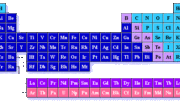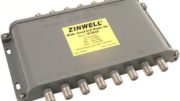Does it really matter what cables you use? Do you have a box of old cables in the garage? I do. When I need something, I’ll dig down into that box and pull out the closest alternative. It may not be the “Mr. Right” of cables but sometimes I just want the “Mr. Right Now” of cables. I decided to line up four cables and see how they’re built and how they perform.
I specifically decided not to use a signal meter to do my tests. I want to judge these bad boys on the only thing that matters… real world performance. I’m going to make them do what they’re supposed to do: pass a satellite signal. I’m going to test each one for a minimum of 2 hours to see what they do. I want to know if it’s worth it to get new cables whenever I need them, and I want to know if it’s worth calling my friends at Solid Signal every time I need a new cable.
Here’s the testing regimen: Each cable will be connected to a DIRECTV splitter on one side and to a DIRECTV DVR on the other. I’m going to test multi-room viewing, playback, on demand downloads, everything I can think of. These are going to be indoor tests in a residence, so I don’t need weatherized cable or anything like that. So, let’s meet the contenders.
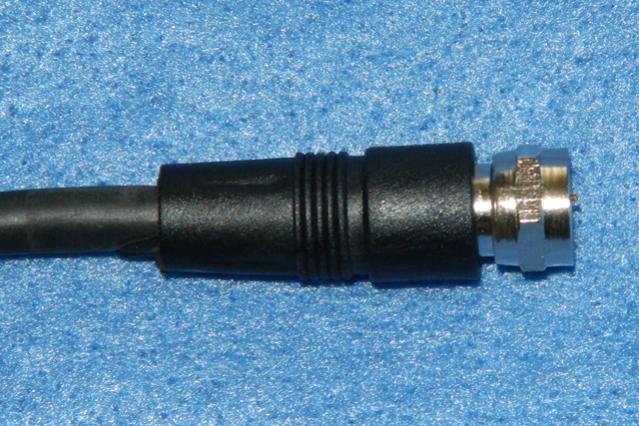
Cable #1 is the “6 ft. Coaxial Cable with Twist-On Connectors” by Uninex. I bought it for 99 cents at a store called, fittingly, 99¢ Only. It says on the packaging it is good for “Satellite Services to TV.” We’ll see.
Looking at this cable, it’s pretty pathetic. The connection looks and feels like the cheap metal used in toys you get out of the gumball machine in the front of the supermarket. There’s a molded shroud around the cable that doesn’t quite look like it’s on straight. The whole cable feels weak and wimpy. But will it perform?

Cable #2 was provided to me by a cable TV installer in the spring of 2000. He didn’t charge me for it. It’s got a solid feel to it and the connector is stamped “PPC RG6U OO”. It’s hard to be sure but I think it’s outdoor rated RG6 cable. The cable is nice and stiff and the connector is firm. I haven’t used it since I got satellite because the satellite installer said that only cables with compression connectors would work. This is a classic hex crimp connector but it looks really great. After 17 years it isn’t falling apart at all.
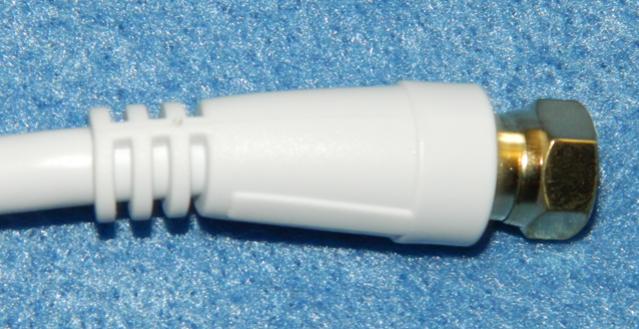
Cable #3 is the Philips SWV2172H/17 RG6 coaxial cable. It was $3.99 from Lowes. I bought it about ten years ago because it’s all I could get in an emergency. It’s clean and firm with a molded shroud that has a good strain relief on the end of it.
The thing that gets me about this cable is the gold colored ends. You know for $4 you’re not getting a lot of gold there. Not that it matters, since gold connectors are one of the biggest crocks there are. They may have made a difference to your record player in 1986 — and I’m not saying they did — but they are not going to do anything to help satellite reception. Not only that, I’m pretty sure there isn’t really any gold. The color is wrong. It’s more likely that this cable was dipped in a little yellow lacquer, which probably hurts its performance if it does anything at all.
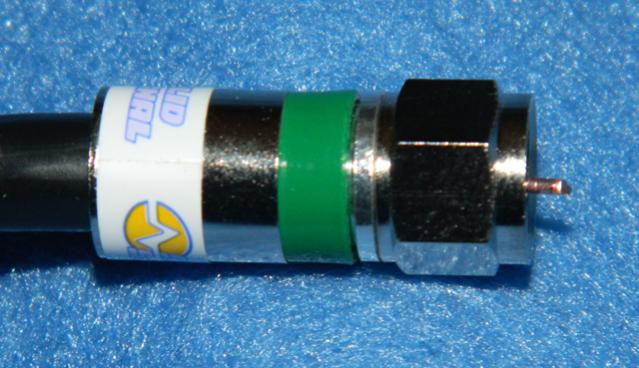
Cable #4 is a quad shielded custom RG6 Solid-Signal-branded cable made for me by my friends up at corporate headquarters in Novi, MI. This thing is a beast. It’s got a firm cable that resists bending, a nice thick copper wire sticking out a decent distance, and a compression connector that looks strong enough to hold up a freeway footing. This is the King Kong of cables, the monster truck-meets-Rambo of cables. This is the stuff they use in professional installations. If you want to run satellite line through a nuclear core, this is probably the stuff you would use.*
*Please don’t go into a nuclear core for any reason and even if you do, I’m exaggerating for effect. Don’t put satellite line in there.
In future tutorials, each one of these cables is going to have the opportunity to show what it’s made of. I’ll get the good, the bad, and the indifferent. If there’s a reason to use a $9 cable, I’ll see it. On the other hand, the $1 cable from the el cheapo store might just save the day!



